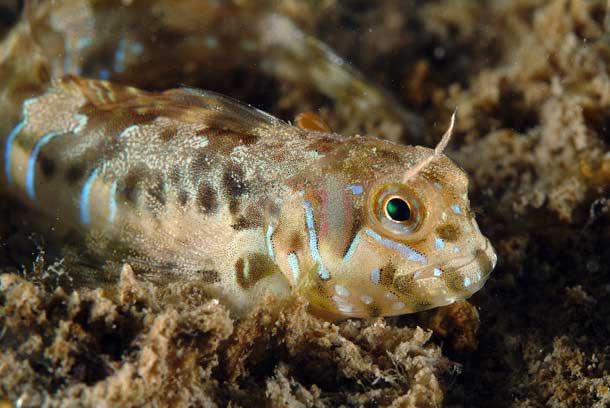
Aidablennius sphynx (*), Photo by Stefano Guerrieri.
Superregnum : Eukaryota
Regnum: Animalia
Subregnum: Eumetazoa
Cladus: Bilateria
Cladus: Nephrozoa
Superphylum: Deuterostomia
Phylum: Chordata
Cladus: Craniata
Subphylum: Vertebrata
Infraphylum: Gnathostomata
Megaclassis: Osteichthyes
Superclassis/Classis: Actinopterygii
Classis/Subclassis: Actinopteri
Subclassis/Infraclassis: Neopterygii
Infraclassis: Teleostei
Megacohors: Osteoglossocephalai
Supercohors: Clupeocephala
Cohors: Euteleosteomorpha
Subcohors: Neoteleostei
Infracohors: Eurypterygia
Sectio: Ctenosquamata
Subsectio: Acanthomorphata
Divisio/Superordo: Acanthopterygii
Subdivisio: Percomorphaceae
Series: Ovalentaria
Superordo: Blenniimorphae
Ordo: Blenniiformes
Subordo: Blennioidei
Familia: Blenniidae
Genus: Aidablennius
Species: Aidablennius sphynx
Name
Aidablennius sphynx (Valenciennes in Cuvier and Valenciennes, 1836)
Synonyms
Aidablennius sphinx (Günther, 1861)
Blennius sphinx Günther, 1861
Blennius sphynx Valenciennes, 1836
Vernacular names
català: Rabosa de roca
English: Sphinx blenny
français: Blennie sphinx
hrvatski: Babica kokošica
italiano: Bavosa sfinge
українська: Морський собачка сфінкс
The sphinx blenny (Aidablennius sphynx) is a species of combtooth blenny, and the only species in the genus Aidablennius.[3] It was described by Achille Valenciennes in 1836, originally under the genus Blennius,[4] and was later reassigned under "Aidablennius" by Gilbert Percy Whitley in 1947. It is a subtropical blenny known from Morocco, in the eastern Atlantic Ocean, and also from the Mediterranean and Black Seas.[5] Sphinx blennies inhabit shallow, rocky waters in the littoral zone, with sunlight exposure. They feed primarily on benthic algae, weeds and invertebrates.[6] Sphinx blennies can measure up to 8 centimetres (3.1 in) long in total length.[5]
Reproduction
In mating, the blennies form distinct pairs, and the females lay up to 7000 eggs in a sitting, which are then guarded in burrows by the males.[7] Males are known to cannibalize dead eggs to prevent infection spread amongst the healthy eggs, although in smaller broods they have also been reported consuming living eggs. It is believed that this is due to limited feeding opportunities for the males during breeding, as a result of their restriction to the nests.[8] FishBase considers the blennies to be of Low Vulnerability, with a reproductive doubling time of less than 15 months.[5]
References
Williams, J.; Craig, M.T. (2014). "Aidablennius sphynx". IUCN Red List of Threatened Species. 2014: e.T185168A1775545. doi:10.2305/IUCN.UK.2014-3.RLTS.T185168A1775545.en. Retrieved 20 November 2021.
Synonyms of Aidablennius sphynx at www.fishbase.org.
Species in the genus Aidablennius at www.fishbase.org.
Cuvier, G. and A. Valenciennes, 1836 (July) [ref. 1005] Histoire naturelle des poissons. Tome onzième. Livre treizième. De la famille des Mugiloïdes. Livre quatorzième. De la famille des Gobioïdes. Histoire naturelle des poissons v. 11: i-xx + 1-506 + 2 pp., Pls. 307-343.
Aidablennius sphynx at www.fishbase.org.
Food items for Aidablennius sphynx at www.fishbase.org.
Reproduction of Aidablennius sphynx at www.fishbase.org.
Kraak, Sarah B. M. (1996). "Female preference and filial cannibalism in Aidablennius sphynx (Teleostei, Blenniidae); a combined field and laboratory study". Behavioural Processes. 36 (1): 85–97. doi:10.1016/0376-6357(95)00019-4.
Retrieved from "http://en.wikipedia.org/"
All text is available under the terms of the GNU Free Documentation License

